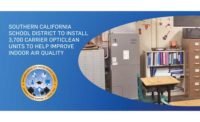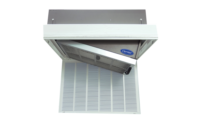Spot exhaust is a unique design engineering challenge. The 2015 ASHRAE Handbook – HVAC Applications covers a broad spectrum of applications in just about all the comfort applications (chapters 1 through 13) and industrial applications (chapters 14 through 33) with personal safety an integral part of chapter 32. But spot return air doesn’t get much press in ASHRAE.
Obviously, there is localized exhaust when using a fume hood or when connecting an exhaust duct to an automobile exhaust pipe when the car is running inside a shop. Kitchen hoods also provide localized exhaust, but what about localized return air? Localized/spot exhaust has its own chapter in the 2015 handbook and the American Conference of Governmental Industrial Hygienists (ACGIH) publication, “Industrial Ventilation: A Manual of Recommended Practice for Design,” is an excellent source for localized exhaust. So why don’t ASHRAE and other organizations provide guidelines for good return air distribution that will also be cost-effective?
I was taught years ago that the majority of air distribution systems are based on design of the supply air, and more specifically, the supply air outlets. As a design engineer, you can influence air distribution and distance of the airflow/throw into the room. An HVAC engineer can design/select a ceiling or wall supply air diffuser/register to produce a laminar flow air stream out of this air device, minimizing the amount of room air that gets induced into the laminar flow air stream.
The engineer can also design/select a supply air nozzle that can discharge supply air out into the room at a velocity that will throw this air 20 ft from the outlet. Supply air diffusers/registers can send the supply air in one, two, or more directions based on the diffuser/register selection. All of this is based on duct air pressure, air velocity, and size and construction of the outlet. You don’t have those engineered options when it comes to return air registers. There really isn’t any room pressure pushing more return air into one side of a two-way ceiling register. The number of return air registers is most likely based on the architectural intent to equal the number of supply air registers for aesthetics within the room.
A good way to understand how return air influences the air distribution of a room is to take a vacuum cleaner and hold your hand about an inch from the suction nozzle. You will feel an air suction pressure and air velocity as the room air is drawn into the vacuum cleaner hose. Now take your hand and place it about 3 ft from the vacuum cleaner hose and you won’t feel the same air velocity, suction pressure, or air flow. In fact, you probably won’t feel anything pertaining to the air being drawn into the vacuum cleaner hose.
So, if you are an HVAC design engineer and the next time you begin to lay out the ceiling showing six supply air diffusers and six return air diffusers to create symmetry, think about how much those five extra diffusers are costing the project with little return on investment.
For this example, I’d budget $400 to furnish and install the return air grille, volume damper, branch runout, and balance the device. Multiply this by five return air registers, and the room has an approximate $2,000 premium. Take that example and add up the total number of supply air diffusers/registers at 600 and compare the cost of 600 return air registers in symmetry versus (say) 80% less return air registers, and that equates to $240,000 for symmetry versus a value engineered $40,800 first cost.
Sure, this is a simplistic example and the single return air grille and associated branch duct will be larger but there can be significant savings based on the return air system design. And maybe the designer isn’t going to be able to reduce the 600 return air registers example based on the 80% less registers ratio, but experience tells me the savings can easily be half if supply-to-return symmetry is not followed. This equates to an approximate savings of $80,000 to $110,000 by just being more aware of how the return air design can be value-engineered. ES




